Blog & Latest Updates
Fly Fishing Articles
Insects by Common Name


Mayfly Family Heptageniidae (March Browns, Cahills, Quill Gordons)
Taxonomic Navigation -?-
Kingdom
Animalia (Animals)
» Phylum
Arthropoda (Arthropods)
» Class
Insecta (Insects)
» Order
Ephemeroptera (Mayflies)
» Family Heptageniidae (March Browns, Cahills, Quill Gordons)
4 genera aren't included.
Common Name
| Match | Common Name |
| March Browns, Cahills, Quill Gordons |
Heptageniids can be broken into "groups" of similar genera (based on angling concerns) to help keep track of them. Although many of them are closely related, they are not officially divided in this way by entomologists. Here are the groups:
Former Stenonema (blotchy wings)
The genus Stenonema, who's Latin name was one of the first etched in the minds of anglers has now been relegated to the minor leagues containing only one species of importance Stenonema femoratum, one of several Lt. Cahills. Its former species of angling legend are now split between the newer genera Maccaffertium and Stenacron. These include the March Brown (prev. S. vicarium) and Gray Fox (prev. S. fuscum) superhatches, further condensed into the one species Maccaffertium vicarium.
The current and former Stenonema species are for all practical purposes limited to the East and Midwest.
Former Heptagenia (plain wings)
While Heptagenia has held on to more species than Stenonema, many of its fishable hatches have been moved to the new genera Leucrocuta, Nixe, and Ecdyonurus. There are many former Heptagenia species across the continent, but few are important to anglers and of those, more are in the West than in the East.
Epeorus (two-tailed Nymphs, plain wings)
The closely related genera Epeorus and Ironodes are among the only mayflies to have just two tails as nymphs. Good populations can be found in the West, but it's in the East where the mayfly named after the man that brought the dry fly to America can be found, the superhatch Epeorus pleuralis or Quill Gordon.
Rhithrogena (suction cup gills)
The genus Rhithrogena can be identified by the gills of its nymphs. They extend underneath the abdomen in the front and the back. They are very important for early season anglers in the West, but not very often in the East. For western anglers, it's duns are the blotchy winged equivalent of the East's March Brown (Maccaffertium vicarium). Ironically, it is only the Western March Brown that is in the same genus as the English species for which the common name originated.
Cinygmula (horn heads)
The genus Cinygmula is easily distinguished by the nymph's enlarged palpi (mouth parts) that stick out from both sides of their heads like little blunt horns. They rarely produce fishable hatches, and none are of much significance except for a few species, mostly in certain locales of the West.
Hatching Behavior
Time Of Day (?): Usually midday moving towards evening as the season progresses
Habitat: Fast water rapids and riffles over stony substrata; The margins also during emergence cycle
Many heptageniid mayflies emerge from their nymphal shucks (Habitat: Fast water rapids and riffles over stony substrata; The margins also during emergence cycle
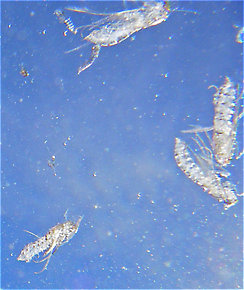
Here's an underwater view of the pupal shucks of several already-emerged Brachycentrus numerosus caddisflies.
Nymph Biology
The Heptageniidae family contains the angler's "clinger" type mayfly nymphs commonly referred to as "Flat Heads" by entomologists. They sport flattened profiles, blunted broad heads, and stout legs suitable for life in fast water. Their flattened tear drop shape is a "miracle" of nature's hydrodynamic engineering employing the same principles used by Formula One race cars to hug the road and reduce wind resistance.
Pictures of 215 Mayfly Specimens in the Family Heptageniidae:
Male Epeorus albertae (Pink Lady) Mayfly Spinner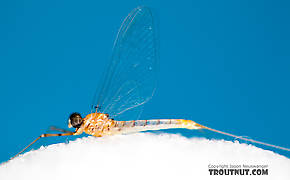 View 14 Pictures
View 14 Pictures
 View 14 Pictures
View 14 PicturesCollected July 11, 2017 from the North Fork Stillaguamish River in Washington
Added to Troutnut.com by Troutnut on July 12, 2017
Added to Troutnut.com by Troutnut on July 12, 2017
Male Nixe inconspicua Mayfly Dun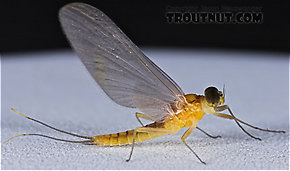 View 13 PicturesThis pretty little dun was part of a sparse midsummer evening hatch on a large Catskill river.
View 13 PicturesThis pretty little dun was part of a sparse midsummer evening hatch on a large Catskill river.
I could not identify it by following a species key step by step, but I tentatively keyed it to the genus Nixe, and based on distribution maps and physical descriptions the most likely species is Nixe inconspicua.
 View 13 PicturesThis pretty little dun was part of a sparse midsummer evening hatch on a large Catskill river.
View 13 PicturesThis pretty little dun was part of a sparse midsummer evening hatch on a large Catskill river.I could not identify it by following a species key step by step, but I tentatively keyed it to the genus Nixe, and based on distribution maps and physical descriptions the most likely species is Nixe inconspicua.
Collected July 13, 2005 from the East Branch of the Delaware River in New York
Added to Troutnut.com by Troutnut on April 14, 2006
Added to Troutnut.com by Troutnut on April 14, 2006
Male Rhithrogena virilis Mayfly Spinner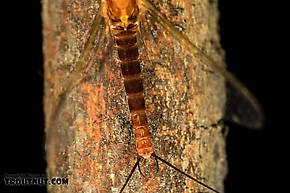 View 12 PicturesI'm fairly sure this is a specimen of Rhithrogena virilis based on closeup examination of the reproductive anatomy under the microscope (not shown in photos). The other other species of Rhithrogena this large is Rhithrogena flavianula, but the key in Needham's Biology of Mayflies mentions annulation in the abdomen (visible in some images on bugguide.net) more distinct than that on this specimen.
View 12 PicturesI'm fairly sure this is a specimen of Rhithrogena virilis based on closeup examination of the reproductive anatomy under the microscope (not shown in photos). The other other species of Rhithrogena this large is Rhithrogena flavianula, but the key in Needham's Biology of Mayflies mentions annulation in the abdomen (visible in some images on bugguide.net) more distinct than that on this specimen.
The body and front wing were both about 15.5 mm long, while the cerci (Cercus: The left and right "tails" of an insect are known as the cerci or caudal cerci. The middle tail of a three-tailed insect is not.) were 40 mm long.
 View 12 PicturesI'm fairly sure this is a specimen of Rhithrogena virilis based on closeup examination of the reproductive anatomy under the microscope (not shown in photos). The other other species of Rhithrogena this large is Rhithrogena flavianula, but the key in Needham's Biology of Mayflies mentions annulation in the abdomen (visible in some images on bugguide.net) more distinct than that on this specimen.
View 12 PicturesI'm fairly sure this is a specimen of Rhithrogena virilis based on closeup examination of the reproductive anatomy under the microscope (not shown in photos). The other other species of Rhithrogena this large is Rhithrogena flavianula, but the key in Needham's Biology of Mayflies mentions annulation in the abdomen (visible in some images on bugguide.net) more distinct than that on this specimen.The body and front wing were both about 15.5 mm long, while the cerci (Cercus: The left and right "tails" of an insect are known as the cerci or caudal cerci. The middle tail of a three-tailed insect is not.) were 40 mm long.
Collected July 5, 2017 from the South Fork Sauk River in Washington
Added to Troutnut.com by Troutnut on July 6, 2017
Added to Troutnut.com by Troutnut on July 6, 2017
11 Underwater Pictures of Heptageniidae Mayflies:
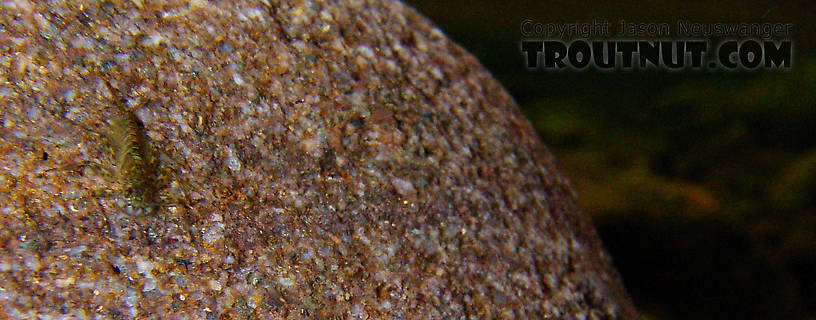
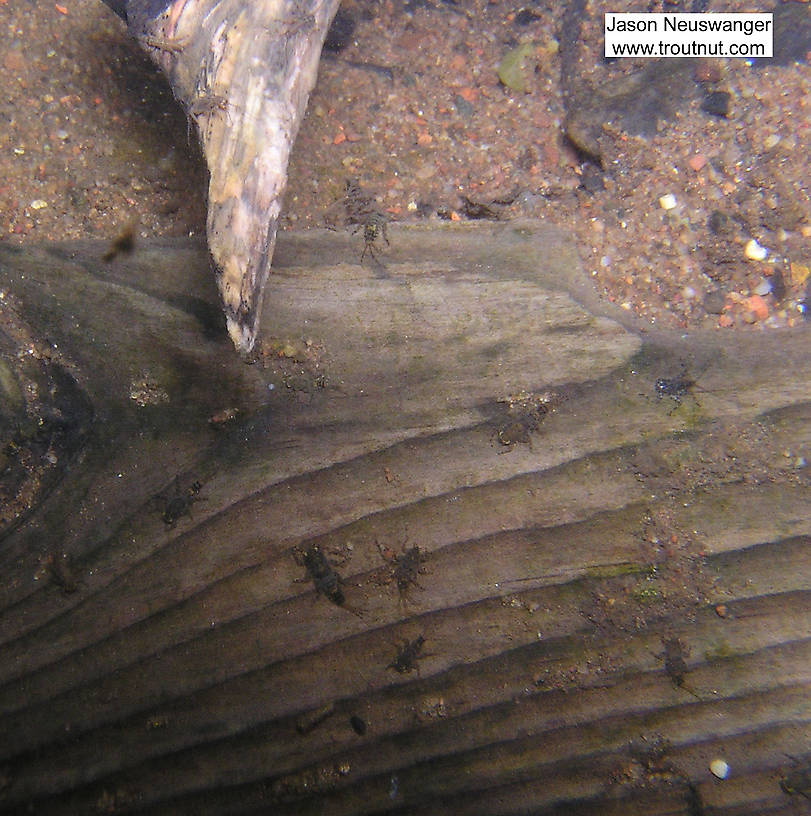
This log houses several Ephemerella mayfly nymphs and, on the top right, an Epeorus mayfly nymph.
In this picture: Mayfly Species Ephemerella invaria (Sulphur Dun) and Mayfly Genus Epeorus (Little Maryatts).
In this picture: Mayfly Species Ephemerella invaria (Sulphur Dun) and Mayfly Genus Epeorus (Little Maryatts).
StateWisconsin
LocationNamekagon River
Date TakenMar 24, 2004
Date AddedJan 25, 2006
AuthorTroutnut
CameraOlympus C740UZ
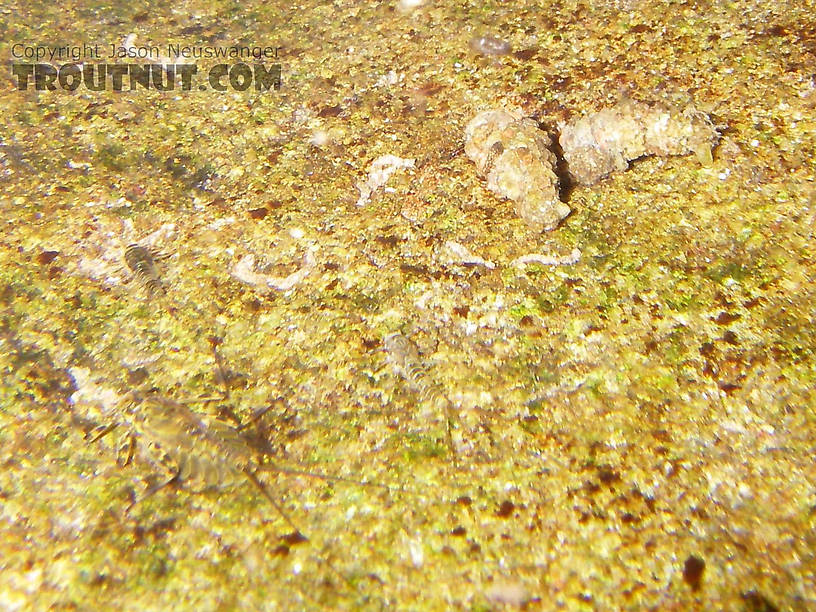
In this picture: Mayfly Genus Epeorus (Little Maryatts), Insect Order Trichoptera (Caddisflies), and Mayfly Family Baetidae (Blue-Winged Olives).
StateNew York
LocationMongaup Creek
Date TakenApr 19, 2006
Date AddedApr 22, 2006
AuthorTroutnut
CameraPENTAX Optio WPi
Recent Discussions of Heptageniidae
Clinger nymphs are shaped that way to hang in really fast currents. Really? 14 Replies »
Posted by Entoman on Feb 24, 2013 in the genus Rhithrogena
Last reply on Jun 14, 2017 by Steamntrout
It is commonly held that clingers are flattened to make their lives better adapted to faster water. Their teardrop shape is certainly a classic symbol of aero and hydrodynamic perfection, so there must be some connection, right? It seems to me that such ideas show a complete misunderstanding of the hydraulic reality in which they live. Current is negligable even in the fastest a few mm. from the surface of solid objects. In fact, it is actually quite calm. I've observed baetids clinging by their tippy toes to the tops of rocks in fast riffles with no apparent effort, often next to clinger species that look like they're hanging on for dear life. What if clinger nymphs are flattened not to hold their place in fast currents but rather to facilitate movement in their ecological niche of the cramped spaces under and between cobble or crevices in other substrate types?
It is also thought that the gills of some species form ''suction'' to hold them in place. Since suction is a phenomena of vacuum creation in the atmosphere, how are these nymphs accomplishing this underwater? Is it their ultra delicate gills that hold them in place or a firm claw grip? The horizontal sprawl of the legs masks this as the gills stay in place until the legs brake free. Exposed to the air, the gills seem to laminate against the rock, just as crepe paper would if first held underwater before a rock was lifted out into the air from underneath it. However, underwater their gills behave like the crepe, flowing freely. They are performing their function as gills not suction cups. I find it hard to believe they evolved the way some think merely so they can make it more difficult for humans to pluck them from rocks in the atmosphere. How is it these mighty structures that defy our attempts to pry them from the rocks curiously fall off so easily when prodded for inspection a few seconds later in a tray or jostled in a container on the way home?
Even many scientific papers have encouraged these dubious beliefs so it's not just angler myth... And they go unchallenged... Thoughts?
ReplyM. ithaca in M. mediopunctatum section? 3 Replies »It is also thought that the gills of some species form ''suction'' to hold them in place. Since suction is a phenomena of vacuum creation in the atmosphere, how are these nymphs accomplishing this underwater? Is it their ultra delicate gills that hold them in place or a firm claw grip? The horizontal sprawl of the legs masks this as the gills stay in place until the legs brake free. Exposed to the air, the gills seem to laminate against the rock, just as crepe paper would if first held underwater before a rock was lifted out into the air from underneath it. However, underwater their gills behave like the crepe, flowing freely. They are performing their function as gills not suction cups. I find it hard to believe they evolved the way some think merely so they can make it more difficult for humans to pluck them from rocks in the atmosphere. How is it these mighty structures that defy our attempts to pry them from the rocks curiously fall off so easily when prodded for inspection a few seconds later in a tray or jostled in a container on the way home?
Even many scientific papers have encouraged these dubious beliefs so it's not just angler myth... And they go unchallenged... Thoughts?
Posted by GONZO on Sep 1, 2012 in the species Maccaffertium mediopunctatum
Last reply on Sep 4, 2012 by Entoman
Hi Jason,
In this section, the Midwestern nymphs (#573 & #574) with the dark irregular ventral bars across the anterior portion of the sternites look like Maccaffertium mediopunctatum arwini (the Midwestern ssp.), but the two Eastern duns (#733 & #765) and the associated shuck (of #765) and nymph (#764) look more like Maccaffertium ithaca to me.
Three Maccaffertium species can have very similar ventral markings in the nymph—dark, sinuate, chevron-shaped bars on many of the sternites and dark lateral marks (sometimes connected to form an inverted U-shaped mark) on segment 9. The Eastern mediopunctatum subspecies, M. m. mediopunctatum, has these markings, as does M. ithaca. Similar markings also appear as a less-common variant marking of M. modestum (or the M. modestum species complex). However, these species differ in the length and location of posterolateral projections, leg markings, the appearance of the subs and adults, and size.
Although interpretation of posterolateral projections can be tricky, those projections should help to separate the nymph (and husk) from mediopunctatum. On mediopunctatum, projections are usually on segments 3-9, 4-9, or 5-9, and those on 8 and 9 are fairly long. On ithaca, projections are usually on segments 6-9 or 7-9, and those on 8 and 9 are somewhat shorter (when compared to mediopunctatum). The twin brown bands on the femora of the nymphs should also help to separate them from modestum and mediopunctatum (usually three or four in those species).
The brown posterior margins and median dorsal stripes of the duns (similar to those found in M. vicarium) are typical of ithaca. In McDunnough’s original description of mediopunctatum (1926), he mentions that some of his (paratype) specimens were reared from subimagos, and he describes those subimagos as “quite pale whitish in coloration.”
Size might also be somewhat helpful in distinguishing these specimens from M. m. mediopunctatum (about 7-10 mm at maturity) and modestum (about 8-11 mm at maturity). M. ithaca is about 9-14 mm at maturity. The relatively mature nymph (#764) is at least 11 mm, the female dun (#733) is about 13 mm, and the male dun (#765) is about 11 mm.
When all of these factors are considered, it seems to me that M. ithaca is a more likely ID for the Eastern specimens. (See Bednarik and McCafferty 1979 and Lewis 1974.) I would suggest the following placement for specimens currently in this section:
M. ithaca nymph: http://www.troutnut.com/specimen/764
M. ithaca female dun: http://www.troutnut.com/specimen/733
M. ithaca male dun: http://www.troutnut.com/specimen/765
M. mediopunctatum arwini nymph: http://www.troutnut.com/specimen/573
M. mediopunctatum arwini nymph: http://www.troutnut.com/specimen/574
Best,
Lloyd
ReplyStenonema femoratum male spinner 3 Replies »In this section, the Midwestern nymphs (#573 & #574) with the dark irregular ventral bars across the anterior portion of the sternites look like Maccaffertium mediopunctatum arwini (the Midwestern ssp.), but the two Eastern duns (#733 & #765) and the associated shuck (of #765) and nymph (#764) look more like Maccaffertium ithaca to me.
Three Maccaffertium species can have very similar ventral markings in the nymph—dark, sinuate, chevron-shaped bars on many of the sternites and dark lateral marks (sometimes connected to form an inverted U-shaped mark) on segment 9. The Eastern mediopunctatum subspecies, M. m. mediopunctatum, has these markings, as does M. ithaca. Similar markings also appear as a less-common variant marking of M. modestum (or the M. modestum species complex). However, these species differ in the length and location of posterolateral projections, leg markings, the appearance of the subs and adults, and size.
Although interpretation of posterolateral projections can be tricky, those projections should help to separate the nymph (and husk) from mediopunctatum. On mediopunctatum, projections are usually on segments 3-9, 4-9, or 5-9, and those on 8 and 9 are fairly long. On ithaca, projections are usually on segments 6-9 or 7-9, and those on 8 and 9 are somewhat shorter (when compared to mediopunctatum). The twin brown bands on the femora of the nymphs should also help to separate them from modestum and mediopunctatum (usually three or four in those species).
The brown posterior margins and median dorsal stripes of the duns (similar to those found in M. vicarium) are typical of ithaca. In McDunnough’s original description of mediopunctatum (1926), he mentions that some of his (paratype) specimens were reared from subimagos, and he describes those subimagos as “quite pale whitish in coloration.”
Size might also be somewhat helpful in distinguishing these specimens from M. m. mediopunctatum (about 7-10 mm at maturity) and modestum (about 8-11 mm at maturity). M. ithaca is about 9-14 mm at maturity. The relatively mature nymph (#764) is at least 11 mm, the female dun (#733) is about 13 mm, and the male dun (#765) is about 11 mm.
When all of these factors are considered, it seems to me that M. ithaca is a more likely ID for the Eastern specimens. (See Bednarik and McCafferty 1979 and Lewis 1974.) I would suggest the following placement for specimens currently in this section:
M. ithaca nymph: http://www.troutnut.com/specimen/764
M. ithaca female dun: http://www.troutnut.com/specimen/733
M. ithaca male dun: http://www.troutnut.com/specimen/765
M. mediopunctatum arwini nymph: http://www.troutnut.com/specimen/573
M. mediopunctatum arwini nymph: http://www.troutnut.com/specimen/574
Best,
Lloyd
Male Stenonema femoratum collected from the Grand River, Ontario. Note the 3 spots at the hind margins of each of the abdominal segments.
(User-posted images are only viewable in the forum section.)
ReplyAdded more Heptagenia culacantha info 12 Replies »(User-posted images are only viewable in the forum section.)
Posted by Troutnut on Dec 19, 2006 in the species Heptagenia culacantha
Last reply on Feb 8, 2012 by Entoman
I went to the entomology library today and photocopied the 1985 paper that first described this curious species. I've updated the culacantha page with this information.
ReplyRed Heptagenia? 30 Replies »Last reply on Jul 24, 2011 by PaulRoberts
The gills and protruding mouthparts make me think that this might be Cinygmula. I've seen red phase Rhithrogena nymphs, but have never seen this coloration in Cinygmula (or Heptagenia).
ReplyThere are 18 more topics.
Your Thoughts On Heptageniidae:
Top 10 Fly Hatches
Top Gift Shop Designs
Eat mayflies.
Top Insect Specimens
Miscellaneous Sites
Troutnut.com is copyright © 2004-2024 Jason
Neuswanger (email Jason). See my FAQ for information about use of my images.
 privacy policy
privacy policy
